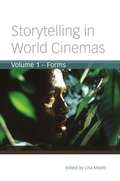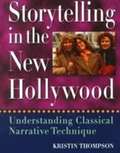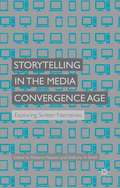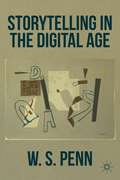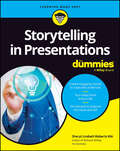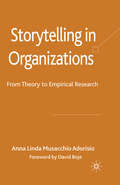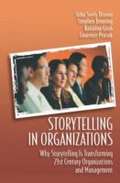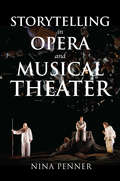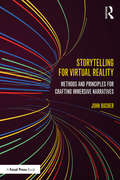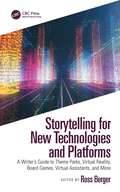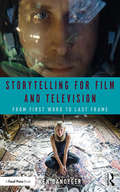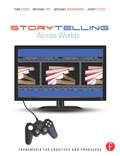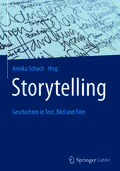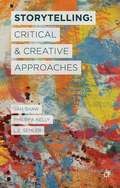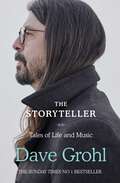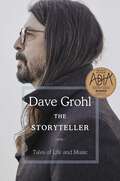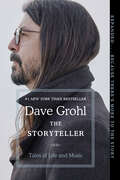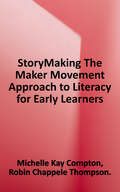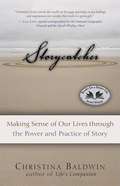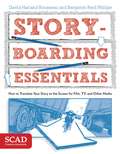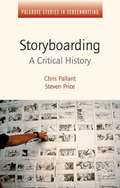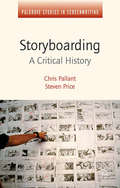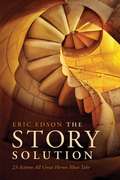- Table View
- List View
Storytelling in World Cinemas: Forms
by Khatib Lina Ed.Storytelling in World Cinemas, Vol. 1: Forms is an innovative collection of essays that discuss how different cinemas of the world tell stories. The book locates European, Asian, African, and Latin American films within their wider cultural and artistic frameworks, showing how storytelling forms in cinema are infused with influences from other artistic, literary, and oral traditions. This volume also reconsiders cinematic storytelling in general, highlighting the hybridity of 'national' forms of storytelling, calling for a rethinking of African cinematic storytelling that goes beyond oral traditions, and addressing films characterised by 'non-narration'. This study is the first in a two-volume project, with the second focusing on the contexts of cinematic storytelling.
Storytelling in the New Hollywood: Understanding Classical Narrative Technique
by Kristin ThompsonKristin Thompson offers the first in-depth analysis of Hollywood's storytelling techniques and how they are used to make complex, easily comprehensible, entertaining films.
Storytelling in the Media Convergence Age
by Roberta Pearson Anthony N. SmithThis collection investigates the relationship between contemporary screen narratives and their varied contexts of production, circulation and reception, exploring storytelling practices across a range of different media and national and institutional sites. While convergence and globalisation blur the boundaries between media and nations, it is still vital to account for the persistent national, medium, institutional and technological specificities that give rise to different narrative forms. The chapters study the ways in which these factors shape events, characters and settings; inform modes of narrative presentation; influence, via paratextual surround, potential interpretations; and accord certain stories more value than others. The authors use case studies drawn from a range of media, from Hollywood franchises to digital comics, and a range of countries, from United States to Japan. In connecting contemporary screen media narratives to their contexts, this book offers a new perspective on recent transformations in screen media culture.
Storytelling in the Digital Age
by W. S. PennThrough a professional story-teller's sometimes humorous commentary on culture and literature from The Odyssey on, Storytelling in the Digital Age suggests that literature is not an artifact to be studied but a living process. Often irreverent, crossing literary and scholarly lines, W. S. Penn aims to discover what literature does for an imaginatively engaged reader. Aimed to amuse, provoke, and propose ideas, this book makes bold new statements about what it means to be human through an interrogation of a variety of stories told and re-told over thousands of years.
Storytelling in Religious Education
by Susan M. ShawPart I. Foundations of storytelling in religious education Part II. Types of story in religious education Part III. Development and storytelling
Storytelling in Presentations For Dummies
by Sheryl Lindsell-RobertsLearn to influence audiences with storyopia: Stories that take them on a journey from what is to what could be: Storytelling in Presentations For Dummies shows you how to develop and deliver a presentation through storytelling, keeping audience interested, and most importantly, making them heroes that take action towards change. You’ll learn how to cull stories from your own experiences, and before you know it, you’ll have more stories than Aesop has fables. You’ll learn about the latest presentation software, so you can integrate visuals into your presentations and avoid the dreaded “Death by PowerPoint.” You’ll also learn how to deal with challenging on-the-spot situations, deliver investor pitches and executive briefs, and present a paper at a conference. Additionally, find out how to deliver someone else’s content and make it your own. This book will help you level up anywhere you need to present information by mastering the art of savvy presentations—the most effective business communications tools of our time. Identify experiences that can be molded into stories that drive change. Prepare powerful openings to hook your audience right away whether delivering in person, online, or hybrid Have your audience get the most from your presentation with an effective call to action Prepare a storyboard, which is like a frame-by-frame roadmap, that will mesh together what you’ll show and what you’ll tell Leverage software like Canva, Prezi, and Storyboarder to tie your presentation together Enjoy the colorful 8-page mini-booklet, “Storytelling to Storyboarding”This Dummies guide is perfect for any professional who needs to present, and at some time all professionals do. It’s also for entrepreneurs who want to build community and grow their business, in addition to students who want to wow teachers and classmates.
Storytelling in Participatory Arts with Young People: The Gaps in the Story (Palgrave Studies In Play, Performance, Learning, and Development)
by Catherine HeinemeyerThis book draws on the author’s experience as a storyteller, drama practitioner and researcher, to articulate an emerging dialogic approach to storytelling in participatory arts, educational, mental health, youth theatre, and youth work contexts. It argues that oral storytelling offers a rich and much-needed channel for intergenerational dialogue with young people.The book keeps theory firmly tethered to practice. Section 1, ‘Storyknowing’, traces the history of oral storytelling practice with adolescents across diverse contexts, and brings into clear focus the particular nature of the storytelling exchange and narrative knowledge. Section 2, ‘Telling Stories’, introduces readers to some of the key challenges and possibilities of dialogic storytelling by reflecting on stories from the author’s own arts-based practice research with adolescents, illustrating these with young people’s artistic responses to stories. Finally, section 3, ‘Story Gaps’, conceptualises dialogic storytelling by exploring three different ‘gaps’: the gap between storyteller and listener, the gaps in the story, and the gaps which storytellers can open up within institutions. The book includes chapters taking a special focus on storytelling in schools and in mental health settings, as well as guided reflections for readers to relate the issues raised to their own practice.
Storytelling in Organizations
by Anna Linda Musacchio AdorisioStorytelling in organizations is a notion that encompasses both the stories that the organization produces and the ones told by its members. It provides both an in-depth treatment of the literature on narratives, stories and storytelling and an extensive empirical case from an American banking institution.
Storytelling in Organizations: Why Storytelling Is Transforming 21st Century Organizations and Management
by John Seely Brown Stephen Denning Katalina Groh Laurence Prusak"Storytelling in Organizations" studies how four busy executives found themselves using storytelling to understanding and managing organizations. The authors describe their own experiences working on knowledge management, change management, and innovation strategies in such organizations as Xerox, the World Bank, and IBM.
Storytelling in Opera and Musical Theater (Musical Meaning and Interpretation)
by Nina PennerStorytelling in Opera and Musical Theater is the first systematic exploration of how sung forms of drama tell stories. Through examples from opera's origins to contemporary musicals, Nina Penner examines the roles of character-narrators and how they differ from those in literary and cinematic works, how music can orient spectators to characters' points of view, how being privy to characters' inner thoughts and feelings may evoke feelings of sympathy or empathy, and how performers' choices affect not only who is telling the story but what story is being told. Unique about Penner's approach is her engagement with current work in analytic philosophy. Her study reveals not only the resources this philosophical tradition can bring to musicology but those which musicology can bring to philosophy, challenging and refining accounts of narrative, point of view, and the work-performance relationship within both disciplines. She also considers practical problems singers and directors confront on a daily basis, such as what to do about Wagner's Jewish caricatures and the racism of Orientalist operas. More generally, Penner reflects on how centuries-old works remain meaningful to contemporary audiences and have the power to attract new, more diverse audiences to opera and musical theater. By exploring how practitioners past and present have addressed these issues, Storytelling in Opera and Musical Theater offers suggestions for how opera and musical theater can continue to entertain and enrich the lives of 21st-century audiences.
Storytelling for Virtual Reality: Methods and Principles for Crafting Immersive Narratives
by John BucherStorytelling for Virtual Reality serves as a bridge between students of new media and professionals working between the emerging world of VR technology and the art form of classical storytelling. Rather than examining purely the technical, the text focuses on the narrative and how stories can best be structured, created, and then told in virtual immersive spaces. Author John Bucher examines the timeless principles of storytelling and how they are being applied, transformed, and transcended in Virtual Reality. Interviews, conversations, and case studies with both pioneers and innovators in VR storytelling are featured, including industry leaders at LucasFilm, 20th Century Fox, Oculus, Insomniac Games, and Google. For more information about story, Virtual Reality, this book, and its author, please visit StorytellingforVR.com
Storytelling for New Technologies and Platforms: A Writer’s Guide to Theme Parks, Virtual Reality, Board Games, Virtual Assistants, and More
by Ross BergerWant to know what it’s like to write for a theme park attraction? Or an interactive toy? Or for a virtual reality game? Wait – those tell stories? And there are jobs for people to write them? Thanks to technology, interactive products and live experiences can now engage us with memorable characters and exciting adventures that were once only destined for the cinema. Storytelling for New Technologies and Platforms: A Writer’s Guide to Theme Parks, Virtual Reality, Board Games, Virtual Assistants, and More is a handbook for writers, students, producers, teachers, scholars, career changers, early tech adopters, and just about anyone who loves story and technology. As a collection of articles from some of the best creative writers in their medium, this book will prepare content creators of tomorrow to tackle some of today's most exhilarating creative challenges found on a screen ... or off! Key Features: Expert advice from several industry professionals who have worked for some of the world’s biggest tech and interactive companies. Best practices that not only guide writers on how to apply their craft to new fields, but also prepare them for the common ambiguity they will find in corporate and start-up environments. Breakdown of platforms that shows how tech capabilities can fulfill content expectations and how content can fulfill tech expectations. Basic storytelling mechanics customized to today’s popular technologies, live experiences, and traditional game platforms.
Storytelling for Film and Television: From First Word to Last Frame
by Ken DancygerStorytelling for Film and Television is a theory and practice book which offers a definitive introduction to the art of storytelling through writing, directing, and editing. Author Ken Dancyger provides a comprehensive explanation of the tools that underpin successful narrative filmmaking and television production. The book takes a unique approach by connecting the different phases of the creative process of film and television production. It shows how writing, directing, and editing all contribute to the process of storytelling and function together to advance the narrative goals of a screenplay, to tell the best story. A case study approach provides numerous examples of effectiveness and brings together the core areas of aesthetics and production to make these concepts more accessible. Case studies include classic and modern films, foreign films, limited and series television, with examples including Breaking Bad, Game of Thrones, The Revenant, and Son of Saul. This is the ideal text for film and television production students at all levels. It is written in a style which makes it accessible to anybody interested in learning more about the storytelling process and is written for a global audience addressing a global industry.
Storytelling Across Worlds: Transmedia for Creatives and Producers
by Tom DowdDon’t restrict your creative property to one media channel. Make the essential leap to transmedia! From film to television to games and beyond, Storytelling Across Worlds gives you the tools to weave a narrative universe across multiple platforms and meet the insatiable demand of today’s audience for its favorite creative property. This, the first primer in the field for both producers and writers, teaches you how to: * Employ film, television, games, novels, comics, and the web to build rich and immersive transmedia narratives * Create writing and production bibles for transmedia property * Monetize your stories across separate media channels * Manage transmedia brands, marketing, and rights * Work effectively with writers and producers in different areas of production * Engage audiences with transmedia storytelling Up-to-date examples of current transmedia and cross-media properties accompany each chapter and highlight this hot but sure-to-be enduring topic in modern media.
Storytelling
by Annika SchachDas Buch pr#65533;sentiert eine textlinguistische Analyse von Texten zur Unternehmensgeschichte und widmet sich dem vielzitierten Storytelling-Trend. Anhand von Textexemplaren der DAX30-Unternehmen werden die Textfunktion, Themenentfaltung und Formulierungsspezifika untersucht. Ein besonderer Schwerpunkt liegt in der Fragestellung, inwieweit Narration als Vertextungsstrategie verwendet wird und wie sich die Textexemplare in einer Typologie beschreiben lassen. Die Arbeit stellt zudem einen Bezug zum medienwissenschaftlichen Framing-Ansatz her.
Storytelling: Critical And Creative Approaches
by Jan Shaw Philippa Kelly L. E. SemlerThis collection uses the concept of 'story' to connect literary materials and methods of analysis to wider issues of social and political importance. Drawing on a range of texts, themes include post-colonial literatures, history in literature, old stories in contemporary contexts, and the relationship between creativity and criticism.
The Storyteller: Tales of Life and Music
by Dave GrohlSo, I’ve written a book. Having entertained the idea for years, and even offered a few questionable opportunities (‘It’s a piece of cake! Just do four hours of interviews, find someone else to write it, put your face on the cover, and voila!’), I have decided to write these stories just as I have always done, in my own hand. The joy that I have felt from chronicling these tales is not unlike listening back to a song that I’ve recorded and can’t wait to share with the world, or reading a primitive journal entry from a stained notebook, or even hearing my voice bounce between the Kiss posters on my wall as a child. <p><p> This certainly doesn’t mean that I’m quitting my day job, but it does give me a place to shed a little light on what it’s like to be a kid from Springfield, Virginia, walking through life while living out the crazy dreams I had as young musician. From hitting the road with Scream at 18 years old, to my time in Nirvana and the Foo Fighters, jamming with Iggy Pop or playing at the Academy Awards or dancing with AC/DC and the Preservation Hall Jazz Band, drumming for Tom Petty or meeting Sir Paul McCartney at Royal Albert Hall, bedtime stories with Joan Jett or a chance meeting with Little Richard, to flying halfway around the world for one epic night with my daughters…the list goes on. I look forward to focusing the lens through which I see these memories a little sharper for you with much excitement.
The Storyteller: Tales of Life and Music
by Dave GrohlSo, I&’ve written a book. Having entertained the idea for years, and even offered a few questionable opportunities (&‘It&’s a piece of cake! Just do four hours of interviews, find someone else to write it, put your face on the cover, and voila!&’), I have decided to write these stories just as I have always done, in my own hand. The joy that I have felt from chronicling these tales is not unlike listening back to a song that I&’ve recorded and can&’t wait to share with the world, or reading a primitive journal entry from a stained notebook, or even hearing my voice bounce between the Kiss posters on my wall as a child. This certainly doesn&’t mean that I&’m quitting my day job, but it does give me a place to shed a little light on what it&’s like to be a kid from Springfield, Virginia, walking through life while living out the crazy dreams I had as young musician. From hitting the road with Scream at 18 years old, to my time in Nirvana and the Foo Fighters, jamming with Iggy Pop or playing at the Academy Awards or dancing with AC/DC and the Preservation Hall Jazz Band, drumming for Tom Petty or meeting Sir Paul McCartney at Royal Albert Hall, bedtime stories with Joan Jett or a chance meeting with Little Richard, to flying halfway around the world for one epic night with my daughters…the list goes on. I look forward to focusing the lens through which I see these memories a little sharper for you with much excitement.
The Storyteller: Tales of Life and Music
by Dave GrohlSo, I've written a book. <p><p> Having entertained the idea for years, and even offered a few questionable opportunities ("It's a piece of cake! Just do 4 hours of interviews, find someone else to write it, put your face on the cover, and voila!") I have decided to write these stories just as I have always done, in my own hand. The joy that I have felt from chronicling these tales is not unlike listening back to a song that I've recorded and can't wait to share with the world, or reading a primitive journal entry from a stained notebook, or even hearing my voice bounce between the Kiss posters on my wall as a child. <p><p> This certainly doesn't mean that I'm quitting my day job, but it does give me a place to shed a little light on what it's like to be a kid from Springfield, Virginia, walking through life while living out the crazy dreams I had as young musician. From hitting the road with Scream at 18 years old, to my time in Nirvana and the Foo Fighters, jamming with Iggy Pop or playing at the Academy Awards or dancing with AC/DC and the Preservation Hall Jazz Band, drumming for Tom Petty or meeting Sir Paul McCartney at Royal Albert Hall, bedtime stories with Joan Jett or a chance meeting with Little Richard, to flying halfway around the world for one epic night with my daughters…the list goes on. I look forward to focusing the lens through which I see these memories a little sharper for you with much excitement. <p> <b>New York Times Bestseller</b>
StoryMaking: The Maker Movement Approach to Literacy for Early Learners
by Michelle Kay Compton Robin Chappele ThompsonAfter studying the current research on literacy learning for young children, delving into the beliefs and schools of Reggio Emilia, and discovering the Maker Movement, the authors created StoryMaking. With great success, they implemented it in their diverse and large public school district. StoryMaking shares the processes, first steps, next steps, use for materials, and lessons learned so teachers can implement their versions in their classrooms. The book shares practical suggestions, student samples, photographs, anchor charts, and other forms of documentation.
Storycatcher: Making Sense of Our Lives Through the Power and Practice of Story
by Christina BaldwinStory is the heart of language. Story emotionally moves us to love and hate and can motivate us to change the whole course of our lives. Story can lift us beyond the borders of our individuality to imagine realities of other people, times, and places; to empathize with other beings; to extend our supposing far into the universe. Storytelling - both oral tradition and written word - is the foundation of being human. In her powerful new book, Christina Baldwin, one of the visionaries who started the personal writing movement, explores the vital necessity of re-creating a sacred common ground for each other's stories. Each chapter in Storycatcher is carried by a fascinating tale - about people, family, or community - intertwined with practical instruction about the nature of story, how it works and how we can practise it in our lives. The art of storycatching invites us to spend time speaking and listening, writing and reading, reclaiming the meaning missing from our lives. This book passionately calls for humanity to hang on to its voice, its love of reading and writing, and its understanding that story is our soul. Whether exploring the personal stories revealed in our private journals, the stories of family legacy, the underlying stories that drive our organizations, or the stories that define our broadest definitions of identity, Christina encourages us all to become storycatchers - people who value story and find ways in the midst of everyday life to practise storytelling. Baldwin shows us how new stories lay the framework for a new world.
Storyboarding Essentials: SCAD Creative Essentials (How to Translate Your Story to the Screen for Film, TV, and Other Media)
by Benjamin Reid Phillips David Harland RousseauA comprehensive guide to visual storytelling from Savannah College of Art and Design (SCAD), one of the world's leaders in sequential arts instruction. Storyboarding is the process of graphically organizing a project--a motion picture, animation, motion graphic, or interactive media sequence--in order to translate artists' ideas from story to screen. Whether you're a filmmaker, animator, ad director, writer, or video-game artist--storyboarding is a skill that is absolutely critical. Storyboarding Essentials covers everything students and working professionals need to master the art of writing and formatting scripts, creating frames, and following visual logic to create a cohesive narrative.
Storyboarding: A Critical History (Palgrave Studies In Screenwriting)
by Steven Price Chris PallantStoryboarding.
Storyboarding: A Critical History (Palgrave Studies in Screenwriting)
by Steven Price Chris PallantThis study provides the first book-length critical history of storyboarding, from the birth of cinema to the present day and beyond. It discusses the role of storyboarding in key films including Gone with the Wind , Psycho and The Empire Strikes Back , and is illustrated with a wide range of images.
The Story Solution: 23 Actions All Great Heroes Must Take
by Eric EdsonEric Edson has developed a new tool for bringing depth and passion to any screenplay - the ""23 Steps All Great Heroes Must Take."" It's an easy to understand paradigm that provides writers and filmmakers the interconnecting, powerful storytelling elements they need. With true insight, a master teacher of screenwriting pinpoints the story structure reasons most new spec scripts don't sell; then uses scores of examples from popular hit movies to present, step by step, his revolutionary Hero Goal Sequences blueprint for writing blockbuster movies.
